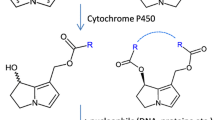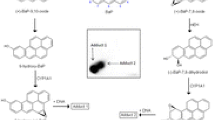Summary
The aim of our study was to determine which microsomal cytochrome P450 isozyme(s) were responsible for the microsomal oxidation of indole to indoxyl, an important intermediate in the information of the uremic toxin indoxyl sulfate. Indole was incubated together with an NADPH — generating system and rat liver microsomes. Formation of indigo, an auto-oxidation product of indoxyl, was used to determine the indole-3-hydroxylation activity. Apparent Km and Vmax values of 0.85 mM and 1152 pmol min−1 mg−1 were calculated for the formation of indoxyl from indole using rat liver microsomes. The effects of various potential inducers and inhibitors on the metabolism of indole to indoxyl by rat liver microsomes were studied to elucidate the enzymes responsible for metabolism. Studies with general and isozyme-specific P450 inhibitors demostrated that P450 enzymes and not FMO are responsible for the formation of indoxyl. In the induction studies, rate of indoxyl formation in the microsomes from untreated vs induced rats correlated nearly exactly with the CYP2E1 activity (4-nitrophenol 2-hydroxylation). These results suggests that CYP2E1 is the major isoform for the microsomal oxidation of indole to indoxyl.
Similar content being viewed by others
References
Bryan G.T. (1971): The role of urinary tryptophan metabolites in the etiology of bladder cancer. Am. J. Clin. Nutt., 24, 841–847.
Dunning W.F., Curtis M.R. (1958): The role of indole in incidence of 2-acetylaminofluorene-induced bladder cancer in rats. Proc. Soc. Exp. Biol. Med., 99, 91–95.
Oyasu R., Kitajima T., Hopp M.L., Sumie H. (1972): Enhancement of urinary bladder tumorigenesis in hamsters by coadministration of 2-acetylaminofluorene and indole. Cancer Res., 32, 2027–2033.
Sims J., Renwick A.G. (1983): The effects of saccharin on the metabolism of dietary tryptophan to indole, a known cocarcinogen for the urinary bladder of the rat. Toxicol. Appl. Pharmacol., 67, 132–151.
Lawrie C.A., Renwick A.G., Sims J. (1985): The urinary excretion of bacterial amino-acid metabolites by rats fed saccharin in the diet. Food Chem. Toxicol., 23, 445–450.
Niwa T., Nomura T., Sugiyama S., Miyazaki T., Tsukushi S., Tsutsui S. (1997): The protein metabolite hypothesis, a model for the progression of renal failure: an oral adsorbent lowers indoxyl sulfate levels in undialyzed uremic patients. Kidney Int. Suppl., 62, S23-S28.
Niwa T., Aoyama I., Takayama F., Tsukushi S., Miyazaki T., Owada A., Shiigai T. (1999): Urinary indoxyl sulfate is a clinical factor that affects the progression of renal failure. Miner Electrolyte Metab., 25, 118–122.
Miyazaki T., Aoyama I., Ise M., Seo H., Niwa T. (2000): An oral sorbent reduces overload of indoxyl sulphate and gene expression of TGF-betal in uraemic rat kidneys. Nephrol. Dial. Transplant, 15, 1773–1781.
Stanfel L.A., Gulyassy P.F., Jarrard E.A. (1986): Determination of indoxyl sulfate in plasma of patients with renal failure by use of ionpairing liquid chromatography. Clin. Chem., 32, 938–942.
Niwa T., Ise M., Miyazaki T. (1994): Progression of glomerular sclerosis in experimental uremic rats by administration of indole, a precursor of indoxyl sulfate. Am. J. Nephrol., 14, 207–212.
Parkinson A. (1996): Biotransformation of xenobiotics. In: Klaasen C.D. (ed). Casarett and Doull's Toxicology. New York: McGraw-Hill, 113–186.
Wong L.L. (1998): Cytochrome P450 monooxygenases. Curr. Opin. Chem. Biol., 2, 263–268.
Guengerich F.P. (1991): Oxidation of toxic and carcinogenic chemicals by human cytochrome P450 enzymes. Chem. Res. Toxicol., 4, 391–407.
Lieber C.S. (1997): Cytochrome P4502E1. Its physiological and pathological role. Physiol. Rev., 77, 517–544.
Gillam E.M.J., Aguinaldo A.M.A., Notley L.M., Kim D., Mundkowski R.G., Volkov A.A., Arnold F.H., Soucek P., DeVoss J.J., Guengerich F.P. (1999): Formation of indigo by recombinant mammalian cytochrome P450. Biochem. Biophys. Res. Commun., 265, 469–472.
Gillam E.M.J., Notley L.M., Cai H., DeVoss J.J., Guengerich F.P. (2000): Oxidation of indole by cytochrome P450 enzymes. Biochem., 39, 13817–13824.
Li Q.S., Schwaneberg U., Fischer P., Schmid R.D. (2000): Directed evolution of the fatty-acid hydroxlase P450 BM-3 into an indole-hydroxylating catalyst. Chemistry, 6, 1531–1535.
Ingelman-Sundberg M., Oscarson M., MccLellan R.A. (1999): Polymorphic human cytochrome P450 enzymes: an opportunity for individualized drug treatment. Trends Pharmacol. Sci., 20, 342–49.
Turesky R.J., Lang N.P., Butler M.A., Teitel C.H., Kadlubar F.F. (1991): Metabolic activation of carcinogenic heterocyclic amines by human liver and colon. Carcinogenesis, 12, 1839–1845.
Russel G.A., Kaupp G. (1969): Oxidation of carbanions. IV. Oxidation of indoxyl to indigo in basic solution. J. Am. Chem. Soc., 91, 3851–3859.
Gorrod J.W., Patterson L.H. (1983): The metabolism of 4-substituted N-ethyl-N-methylanilines III. Effect of various potential inhibitors, activators and inducers on α-C- and N-oxidation. Xenobiotica, 13, 521–529.
Tierney D.J., Haas A.L., Koop D.R. (1992): Degradation of cytochrome P-4502E1: Selective loss after labilization of the enzyme. Arch. Biochem. Biophys., 293, 9–16.
Koop D.R. (1992): Hydroxylation of p-nitrophenol by rabbit ethanol-inducible cytochrome P450 isozyme 3a. Mol. Pharmacol., 29, 399–404.
Perella F.W. (1988): A practical curve-fitting microcomputer program for the analysis of enzyme kinetic data on IBM-PC compatible computers. Anal. Biochem., 174, 437–447.
Grothusen A., Hardt J., Brautigam L., Lang D., Bocker R. (1996): A convenient method to discriminate between cytochrome P450 enzymes and flavin-containing monooxyenases in human liver microsomes. Arch. Toxicol., 71, 64–71.
Chen T.S., Dubois K.P. (1973): Studies on the enzyme inducing effect of polychlorinated biphenyls. Toxicol. Appl. Pharmacol., 26, 504–512.
Okey A.B. (1990): Enzyme induction in the cytochrome P450 system. Pharmacol. Ther., 45, 241–298.
Ryan D.E., Ramanathan L., Iida S., Thomas P.E., Haniu M., Shively J.E., Lieber C.S., Levin W. (1985): Characterization of a major form of rat hepatic microsomal cytochrome P450 induced by isoniazid. J. Biol. Chem., 260, 6385–6393.
Song B.J., Veech R.L., Saenger P. (1990): Cytochrome P450IIE1 is elevated in lymphocytes from poorly controlled insulin-dependent diabetics. J. Clin. Endocrinol. Metab., 71, 1036–1040.
Wang T., Shankar K., Ronis M.J., Mehendale H.M. (2000): Potentiation of thioacetamide liver injury in diabetic rats is due to induced CYP2E1. J. Pharmacol. Exp. Ther., 294, 473–479.
Yoo J.S.H., Yang C.S. (1985): Enzyme specificity in the metabolic activation of N-nitrosodimethylamine to a mutagen for Chinese hamster V79 cells. Cancer Res., 45, 5569–5574.
Gonzales F.J. (1989): The modecular biology of P450s. Pharmacol. Rev., 40, 243–288.
Author information
Authors and Affiliations
Rights and permissions
About this article
Cite this article
Banoglu, E., Jha, G.G. & King, R.S. Hepatic microsomal metabolism of indole to indoxyl, a precursor of indoxyl sulfate. Eur. J. Drug Metab. Pharmacokinet. 26, 235–240 (2001). https://doi.org/10.1007/BF03226377
Received:
Issue Date:
DOI: https://doi.org/10.1007/BF03226377




